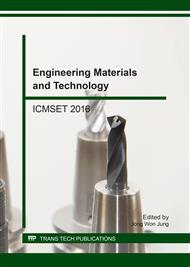[1]
Z. Rutkauskas, A. Bargelis, Knowledge-based method for gate and cold runner definition in injection mold design, Mech. 66(4) (2007) 49-54.
Google Scholar
[2]
C. G. Li, C. L. Li, L. Y, Y. Huang, A new C-space method to automate the layout design of injection mould cooling system, Comput. Aided Des. 44(9) (2012) 811-823.
DOI: 10.1016/j.cad.2012.01.005
Google Scholar
[3]
L. Guangming, F. Hui, Z. Lixuan, Y. Bin, Research on optimal design of the injection mold parting direction based on preference relation, Int. J. Adv. Manuf. Tech. 79(5) (2015) 1027-1034.
DOI: 10.1007/s00170-015-6802-2
Google Scholar
[4]
M. W. Fu, A. Y. C. Nee, J. Y. H. Fuh, The application of surface visibility and moldability to parting line generation, Comput. Aided Des. 34(6) (2002) 469-480.
DOI: 10.1016/s0010-4485(01)00117-8
Google Scholar
[5]
C. L. Li, K. M. Yu, C. G. Li, A new approach to parting surface design for plastic injection moulds using the subdivision method, Int. J. Prod. Res. 43(3) (2007) 537-561.
DOI: 10.1080/00207540512331311895
Google Scholar
[6]
M. W. Fu, J. Y. H. Fuh, A. Y. C. Nee, Core and cavity generation method in injection mould design, Int. J. Prod. Res. 39(1) (2001) 121-138.
DOI: 10.1080/00207540010002379
Google Scholar
[7]
http: /www. pitfallsinmolding. com/weldlinepage. html.
Google Scholar
[8]
J. W. Hu, Response of Seismically Isolated Steel Frame Buildings with Sustainable Lead-Rubber Bearing (LRB) Isolator Devices Subjected to Near-Fault (NF) Ground Motions. Sustain. 7 (2015) 111-137.
DOI: 10.3390/su7010111
Google Scholar
[9]
M. R. Kaloop, J. W. Hu, Y. Bigdeli, Identification of the Response of a Controlled Building Structure Subjected to Seismic Load by Using Nonlinear System Models. Appl. Sci. 6 (2016) 301.
DOI: 10.3390/app6100301
Google Scholar
[10]
B. Hou, Z. Huang, H. Zhou, Y. Zhang, Automated generation of venting system in plastic injection mold, SPE ANTEC™ Indianapolis (2016) 1386-1389.
Google Scholar
[11]
S. C. Chen, S. P. Yang, J. A. Chang, S. P. Sun, H. S. Chiu, C. H. Hsu, Verification of experiment and numerical method simulation on venting design for improving product surface quality, SPE ANTEC™ Indianapolis (2016) 1306-1311.
Google Scholar
[12]
C. H. Wu, W. J. Liang, Effects of Geometry and Injection-Molding Parameters on Weld-Line Strength, Polym. Eng. Sci. 45(7) (2015) 1021-1030.
DOI: 10.1002/pen.20369
Google Scholar
[13]
S. Fathi, A. H. Behravesh, Visualization of the Flow History Contours at the Cross-Section of a Weld-Line in an Injected Molded Part, J. Appl. Polym. Sci. 109(1) (2008) 412-417.
DOI: 10.1002/app.28113
Google Scholar
[14]
C. S. Chen, T. J. Chen, R. D. Chien, S. C. Chen, Investigation on the weldline strength of thin-wall injection molded ABS parts, Int. Commun. Heat. Mass. 34(4) (2007) 448-455.
DOI: 10.1016/j.icheatmasstransfer.2007.01.005
Google Scholar
[15]
N. Merah, M. Irfan-ul-Haq, Z. Khan, Effects of injection molding weld on fatigue crack resistance of CPVC at different temperatures, J. Mater. Process. Technol. 155-156 (2004) 1261-1265.
DOI: 10.1016/j.jmatprotec.2004.04.257
Google Scholar
[16]
M. Koponen, J. Enqvist, T. N. Chung, G. Mennig, Advanced injection molding mold and molding process for improvement of weld line strengths and isotropy of glass fiber filled aromatic polyester LCP, Polym. Eng. Sci. 48(4) (2008) 711-716.
DOI: 10.1002/pen.21010
Google Scholar
[17]
L. Xie, G. Ziegmann, A visual mold with variotherm system for weld line study in micro injection molding, Microsyst. Technol. 14(6) (2008) 809-814.
DOI: 10.1007/s00542-008-0566-7
Google Scholar


